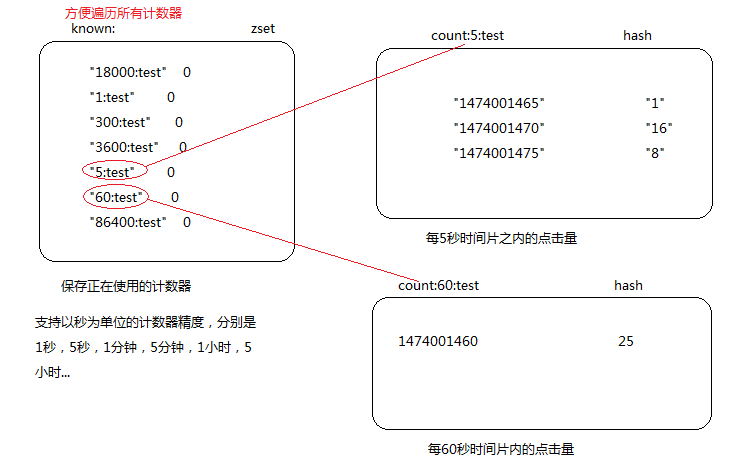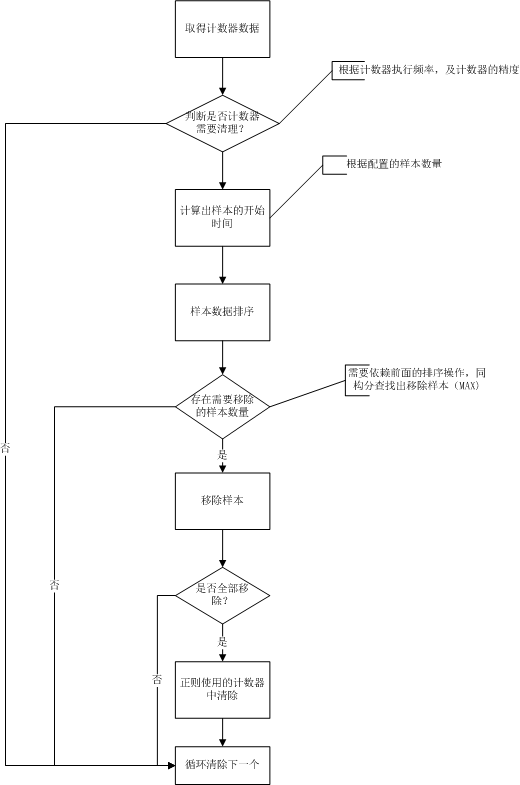redis应用场景日志记录及指标统计
Posted
tags:
篇首语:本文由小常识网(cha138.com)小编为大家整理,主要介绍了redis应用场景日志记录及指标统计相关的知识,希望对你有一定的参考价值。
使用redis存储业务信息,同时也可以存储系统运维信息,比如日志和计数器来收集系统当前的状态信息,挖掘正在使用系统的顾客信息,以及诊断系统问题,发现潜在的问题。当然,系统日志信息及统计信息也可以存储在关系型数据库中,但是存在一个很大的弊端,影响业务性能。
1.使用redis记录日志
熟悉java的朋友,记录日志往往采用的是log4j,sl4j,大多记录载体选择文本文件。如果使用web集群的话,造成日志分散在各个web服务器,搜集有效日志信息,非常麻烦。如果选择数据库保存的话,解决了文件分散情况,但势必对业务造成影响,日志毕竟是个辅助支撑而已,不应该和业务系统相提并论。这时候,redis是一个不错的选择。如果可以的话,可以对log4j扩展,将数据保存到redis中,当然这不是本章的重点。本章重点,主要简单讨论下如何保存日志。
构建一个系统,判断哪些信息需要被记录是一件困难的事情,不同的业务有不同的需求。但一般的日志信息往往关注一下方面。
日志时间,日志内容,服务IP,日志级别,日志发生频率。
1.1redis日志存储设计
记录详情里,可以按要求,增添想要的信息,发生的类名称,处理IP等。
1.2代码
public void logCommon(
Jedis conn, String name, String message, String severity, int timeout) {
String commonDest = "common:" + name + ‘:‘ + severity;
String startKey = commonDest + ":start";
long end = System.currentTimeMillis() + timeout;
while (System.currentTimeMillis() < end){
conn.watch(startKey);
//当前所处的小时数
String hourStart = ISO_FORMAT.format(new Date());
String existing = conn.get(startKey);
Transaction trans = conn.multi();
//如果记录的是上一个小时的日志
if (existing != null && COLLATOR.compare(existing, hourStart) < 0){
trans.rename(commonDest, commonDest + ":last");
trans.rename(startKey, commonDest + ":pstart");
trans.set(startKey, hourStart);
}else{
trans.set(startKey, hourStart);
}
//日志计数器增1
trans.zincrby(commonDest, 1, message);
//记录最近日志详情
String recentDest = "recent:" + name + ‘:‘ + severity;
trans.lpush(recentDest, TIMESTAMP.format(new Date()) + ‘ ‘ + message);
trans.ltrim(recentDest, 0, 99);
List<Object> results = trans.exec();
// null response indicates that the transaction was aborted due to
// the watched key changing.
if (results == null){
continue;
}
return;
}
}2.网站点击量计数器统计
2.1redis计数器存储设计
2.2编码
//以秒为单位的精度
public static final int[] PRECISION = new int[]{1, 5, 60, 300, 3600, 18000, 86400};
public void updateCounter(Jedis conn, String name, int count, long now){
Transaction trans = conn.multi();
//每一次更新,都要更新所有精度的计数器
for (int prec : PRECISION) {
long pnow = (now / prec) * prec;//当前时间片的开始时间
String hash = String.valueOf(prec) + ‘:‘ + name;
trans.zadd("known:", 0, hash);
trans.hincrBy("count:" + hash, String.valueOf(pnow), count);
}
trans.exec();
}
public List<Pair<Integer,Integer>> getCounter(
Jedis conn, String name, int precision)
{
String hash = String.valueOf(precision) + ‘:‘ + name;
Map<String,String> data = conn.hgetAll("count:" + hash);
ArrayList<Pair<Integer,Integer>> results =
new ArrayList<Pair<Integer,Integer>>();
for (Map.Entry<String,String> entry : data.entrySet()) {
results.add(new Pair<Integer,Integer>(
Integer.parseInt(entry.getKey()),
Integer.parseInt(entry.getValue())));
}
Collections.sort(results);
return results;
}2.3清楚旧数据
流程图
代码
public class CleanCountersThread
extends Thread
{
private Jedis conn;
private int sampleCount = 100;
private boolean quit;
private long timeOffset; // used to mimic a time in the future.
public CleanCountersThread(int sampleCount, long timeOffset){
this.conn = new Jedis("192.168.163.156");
this.conn.select(15);
this.sampleCount = sampleCount;
this.timeOffset = timeOffset;
}
public void quit(){
quit = true;
}
public void run(){
int passes = 0;
while (!quit){
long start = System.currentTimeMillis() + timeOffset;
int index = 0;
while (index < conn.zcard("known:")){
Set<String> hashSet = conn.zrange("known:", index, index);
index++;
if (hashSet.size() == 0) {
break;
}
String hash = hashSet.iterator().next();
int prec = Integer.parseInt(hash.substring(0, hash.indexOf(‘:‘)));
int bprec = (int)Math.floor(prec / 60);
if (bprec == 0){
bprec = 1;
}
if ((passes % bprec) != 0){
continue;
}
String hkey = "count:" + hash;
String cutoff = String.valueOf(
((System.currentTimeMillis() + timeOffset) / 1000) - sampleCount * prec);
ArrayList<String> samples = new ArrayList<String>(conn.hkeys(hkey));
Collections.sort(samples);
int remove = bisectRight(samples, cutoff);
if (remove != 0){
conn.hdel(hkey, samples.subList(0, remove).toArray(new String[0]));
if (remove == samples.size()){
conn.watch(hkey);
if (conn.hlen(hkey) == 0) {
Transaction trans = conn.multi();
trans.zrem("known:", hash);
trans.exec();
index--;
}else{
conn.unwatch();
}
}
}
}
passes++;
long duration = Math.min(
(System.currentTimeMillis() + timeOffset) - start + 1000, 60000);
try {
sleep(Math.max(60000 - duration, 1000));
}catch(InterruptedException ie){
Thread.currentThread().interrupt();
}
}
}
// mimic python‘s bisect.bisect_right
public int bisectRight(List<String> values, String key) {
int index = Collections.binarySearch(values, key);
return index < 0 ? Math.abs(index) - 1 : index + 1;
}
}3.使用redis统计数据
上面提到的计数器,是最简单的统计数据。除了计数器(count(*)),还是最大值(max),最小值(min).
设计
stats:模块(页面)名称:指标名称
public List<Object> updateStats(Jedis conn, String context, String type, double value){
int timeout = 5000;
String destination = "stats:" + context + ‘:‘ + type;
String startKey = destination + ":start";
long end = System.currentTimeMillis() + timeout;
while (System.currentTimeMillis() < end){
conn.watch(startKey);
String hourStart = ISO_FORMAT.format(new Date());
String existing = conn.get(startKey);
Transaction trans = conn.multi();
if (existing != null && COLLATOR.compare(existing, hourStart) < 0){
trans.rename(destination, destination + ":last");
trans.rename(startKey, destination + ":pstart");
trans.set(startKey, hourStart);
}
//借助redis提供的最大值,最小值计算
String tkey1 = UUID.randomUUID().toString();
String tkey2 = UUID.randomUUID().toString();
trans.zadd(tkey1, value, "min");
trans.zadd(tkey2, value, "max");
trans.zunionstore(
destination,
new ZParams().aggregate(ZParams.Aggregate.MIN),
destination, tkey1);
trans.zunionstore(
destination,
new ZParams().aggregate(ZParams.Aggregate.MAX),
destination, tkey2);
trans.del(tkey1, tkey2);
trans.zincrby(destination, 1, "count");
trans.zincrby(destination, value, "sum");
trans.zincrby(destination, value * value, "sumsq");
List<Object> results = trans.exec();
if (results == null){
continue;
}
return results.subList(results.size() - 3, results.size());
}
return null;
}需要注意的使用redis自带的最大值最小值,计算,所以创建了2个临时有序集合。其他的逻辑参照日志相关部分。
参考内容
《redis in action》
本文出自 “简单” 博客,请务必保留此出处http://dba10g.blog.51cto.com/764602/1853096
以上是关于redis应用场景日志记录及指标统计的主要内容,如果未能解决你的问题,请参考以下文章



